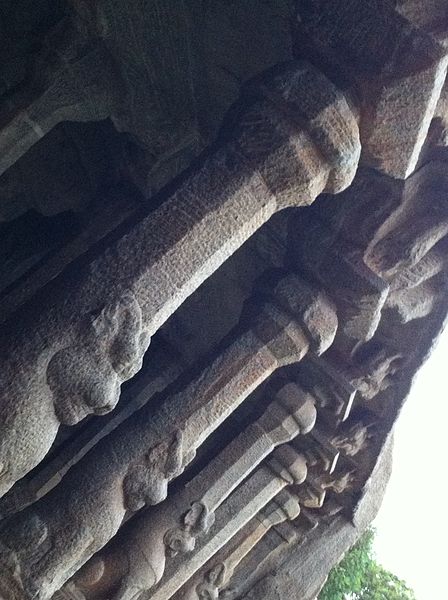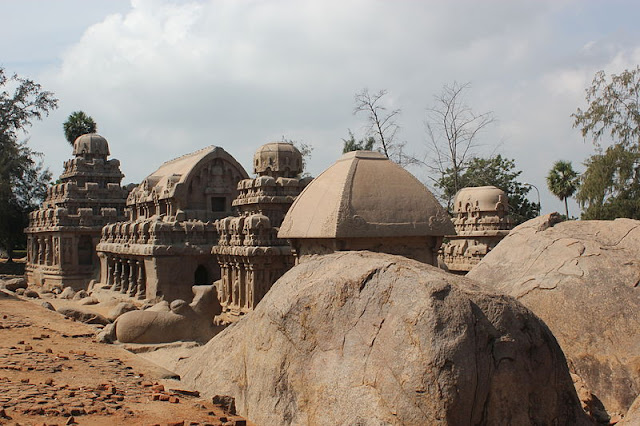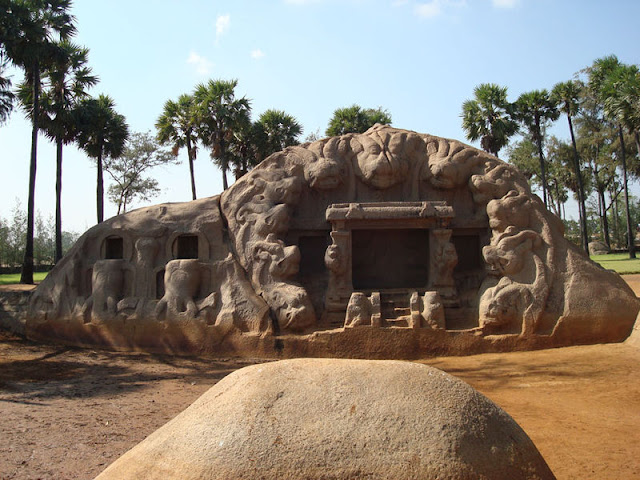Mahabalipuram (Mamallapuram) – General Information
Mahabalipuram, also known
as Mamallapuram is a town in Kancheepuram district in the Indian state of Tamil
Nadu. It is around 60 km south from the city of Chennai. It is an ancient historic town and was a bustling
seaport during the time of Periplus (1st century CE) and Ptolemy (140 CE). Ancient Indian traders who went to
countries of South East Asia sailed from the seaport of Mahabalipuram.



By the 7th century it was
a port city of South Indian dynasty of the Pallavas. It has a group of sanctuaries, which was carved out of
rock along the Coromandel coast in the 7th and 8th centuries : rathas (temples in the form of chariots), mandapas (cave sanctuaries), giant open-air reliefs such as the famous 'Descent of the Ganges', and
the Shore Temple, with thousands of sculptures to the glory of Shiva. The group of monuments at
Mahabalipuram has been classified
as a UNESCO World Heritage Site.



It has an average
elevation of 12 metres (39 feet). The modern city of Mahabalipuram
was established by the British
Raj in 1827.
The total land area is an
8 square kilometers, situated exactly to the mean sea level. The population of
this place is 12,000. The climate is moderate and breezy due to the location of
the sea close to the land. Tamil and English are the two languages spoken here.
There is no specific season for the tourists to visit Mahabalipuram as it can be
visited in, at any past of the year. The nearest Airport is in Chennai. The
nearest railway is in Chengalpattu and it is well connected by road ways. The
(ECR) East coastal road which connects Chennai and Pondicherry passes through
this place.
Climate
This city has a tropical
climate. In winter, there is much less rainfall than in summer. The
Köppen-Geiger climate classification is Aw. The average annual temperature in
Mamallapuram is 28.4 °C. In a year, the average rainfall is 1219 mm. The
temperatures are highest on average in May, at around 32.6 °C. In January, the
average temperature is 24.3 °C. It is the lowest average temperature of the
whole year. The variation in the precipitation between the driest and wettest
months is 309 mm. The average temperatures vary during the year by 8.3 °C.
History
Megalithic burial urn,
cairn circles and jars with burials dating to the very dawn of the Christian
era have been discovered near Mamallapuram. The Sangam
age poem Perumpanattuppadai relates the rule of King Thondaiman Ilam Thiraiyar
at Kanchipuram of the Thondai
Nadu port Nirppeyyaru which scholars identify
with the present-day Mamallapuram. Chinese coins and Roman coins of Theodosius
I in the 4th century CE have been found at
Mamallapuram revealing the port as an active hub of global trade in the late
classical period.



Two Pallava coins bearing legends read as Srihari and Srinidhi
have been found at Mamallapuram. The Pallava kings ruled Mamallapuram from Kanchipuram; the capital of the Pallava dynasty from the 3rd
century to 9th century CE, and used the port to launch trade and diplomatic
missions to Sri Lanka and Southeast Asia.



An 8th-century Tamil text
written by Thirumangai Alvar described this place as Sea Mountain ‘where the
ships rode at anchor bent to the point of breaking laden as they were with wealth,
big trunked elephants and gems of nine varieties in heaps’. It is also known by
several other names such as Mamallapattana and Mamallapuram. Another name by
which Mahabalipuram has been known to mariners, at least since Marco
Polo’s time is "Seven Pagodas" alluding to
the Seven Pagodas of Mahabalipuram that stood on the shore, of which one, the Shore
Temple, survives.








Mamallapuram, the city of
Mamalla, is after the title of great Pallava ruler Narasimhavarman-I (AD
630-68). It was a sea-port during the time of Periplus (1st century AD) and
Ptolemy (AD 140) and many Indian colonists sailed to South-East Asia through
this port town. While there is some evidence of architectural activity going
back to the period of Mahendravarman-I (AD 600-30), the father of Mamalla, most
of the monuments like rock-cut rathas, sculptured scenes on open rocks like
Arjuna's penance, the caves of Govardhanadhari and Mahishasuramardhini, the
Jala-Sayana Perumal temple (the sleeping Mahavishnu or Chakrin at the rear part
of the Shore temple complex) are attributed to the period of Narasimhavarman-I
Mamalla.








Of the nine monolithic
temples found in Mahabalipuram, the most important are Five Rathas known after
the famous five Pandava brothers of the Mahabharata fame. These monuments are
carved out a single rock with choice of all known forms of plan and elevations.
While the Dharmaraja, Arjuna and Draupadi rathas are square on plan, the Bhima
and Ganesa rathas are rectangular and Sahadeva ratha apsidal.










The Draupadi ratha is a simple
hut like Kutagara shrine while the Arjuna ratha is a dvitala Vimana with a
mukhamandapa. The Bhima ratha is rectangular on plan with a salakara
wagon-vaulted roof. The Dharmaraja ratha is a tritala Vimana having functional
shrines at all the talas. The Nakula-Sahadeva ratha with an apsidal plan and
elevation indicate the experimental tendency of the architect.
Though monolithic
sculpturing, both cut-in and cut-out, continued even during later periods
(Atiranachanda cave, Pidari rathas and Tiger-cave), the structural architecture
was introduced on a grand scale by Pallava Rajasimha (AD 700-28), culminating
in erection of the world famous Shore temple. The Shore temple is a complex of
three temples, viz, Rajasimhesvara (a small tritala Vimana facing west), the
Kshatriyasimhesvara (the larger east facing Vimana) and Narapatisimha Pallava
Vishnugriha (an east facing, oblong, flat-roofed mandapa shrine) housing the
reclining Vishnu. These shrines are enclosed by two prakara walls with openings
constructed in later times. The inner surface of prakara walls once contained
panel sculptures which are worn out now.










The notable cave temples
here are the Varaha mandapa, Mahishamardini mandapa, Paramesvara Maha varaha
Vishnugriha (Adivaraha cave). These are in the Mamalla style while the
Atiranachanda caves temples belong to the Mahendra period.
The caves here were once
plastered and painted as indicated by the remains. After Rajasimha, there is
lull in the architectural activity of the place, save a few additions during
late-Pallava and Chola times. The grandiose Vijayanagara phase here is
represented by the Raja Gopurams and the Sthala-Sayana temple, juxtaposed to
the carved boulder of Arjuna's penance.










Recent excavations to the
north and south of the Shore Temple have revealed rock-cut figures representing
religious themes of period prior to the construction to the temple. Besides, a
monolithic Bhuvaraha, a reclining image of Vishnu, the base of Durga shrine
with deer and a square socket possibly to accommodate mahastambha have also
been exposed. To the south of the Shore Temple was exposed a stepped Ghat
facing the sea.
All but one of the rathas from the first phase of Pallava architecture are modeled on the Buddhist Viharas or monasteries and Chaitya halls with several cells arranged around a
courtyard. Art historian Percy Brown, in fact, traces the possible roots of the Pallava Mandapa to the similar rock-cut caves of Ajanta
Caves and Ellora
Caves. Referring to
Narasimhavarman's victory in AD 642 over the Chalukyan king Pulikesin
II, Brown says the Pallava king may have brought the sculptors and artisans
back to Kanchi and Mamallapuram as 'spoils of war'.










The fact that different
shrines were dedicated to different deities is evidence of an increased sectarianism
at the time of their construction. A bas-relief on a sculpted cliff has an
image of Shiva and a shrine dedicated to Vishnu, indicating the growing
importance of these Sangam
period deities and a
weakening of the roles of Vedic gods such as Indra and Soma.
Landmarks
The monuments are mostly
rock-cut and monolithic, and constitute the early stages of Dravidian architecture where in Buddhist elements of design are prominently visible. They
are constituted by cave temples, monolithic rathas (chariots),
sculpted reliefs and structural temples. The pillars are of the Dravidian
order. The sculptures are excellent examples of Pallava art. They are located
in the side of the cliffs near India's Bay of Bengal.








It is believed by some
that this area served as a school for young sculptors. The different
sculptures, some half finished, may have been examples of different styles of
architecture, probably demonstrated by instructors and practiced on by young students.
This can be seen in the Pancha
Rathas where
each Ratha is sculpted in a different style. These five Rathas were
all carved out of a single piece of granite in situ. While excavating Khajuraho, Alex Evans, a stonemason and sculptor, recreated a
stone sculpture made out of sandstone, which is softer than granite, under
4 feet that took about 60 days to carve. The carving at Mahabalipuram must
have required hundreds of highly skilled sculptors.
In 2004 the Indian Ocean
Tsunami washed away tons of coastal sand exposing structures including a
granite lion and an elephant relief.
Some important structures include:
Thirukadalmallai, temple dedicated to Lord Vishnu was also built by
Pallava King in order to safeguard the sculptures from the
ocean. It is told that after building this temple, the remaining architecture
was preserved and was not corroded by sea.
Descent of the Ganges or Bagiratha's Penance – a giant
open-air bas relief
Varaha Cave Temple – a small rock-cut temple dating back to the 7th
century.
The Shore
Temple – a structural
temple along the Bay
of Bengal with the entrance
from the western side away from the sea. Recent excavations have revealed new
structures here.
Pancha Rathas (Five Chariots) – five monolithic pyramidal
structures named after the Pandavas (Arjuna, Bhima, Yudhishtra, Nakula and Sahadeva) and Draupadi. An interesting aspect of the rathas is that, despite
their sizes they are not assembled – each of these is carved from one single
large piece of stone.
Light House, built in
1894.
Demography
As of 2001 India
census, Mahabalipuram had a population of 12,345. Males constitute 52% of
the population and females 48%. Mahabalipuram has an average literacy rate of
74%, higher than the national average of 59.5%: male literacy is 82%, and female
literacy is 66%. In Mahabalipuram, 12% of the population is under 6 years of
age.
Entry
Open from 6 A.M. to 6 P.M.
Entrance Fee:
Citizens of India and
visitors of SAARC (Bangladesh, Nepal, Bhutan, Sri Lanka, Pakistan,
Maldives and Afghanistan) and BIMSTEC Countries (Bangladesh, Nepal, Bhutan, Sri
Lanka, Thailand and Myanmar) - Rs. 10 per head.
Others: US $ 5 or Indian
Rs. 250/- per head
(Children up to 15 years
free)
Activities
· Bike trips around
Tamil Nadu's countryside can be organized by travel agencies in the town.
·
Chill on the
sandy beach
·
Boat rides to in the
Bay of Bengal with life guards.
·
Fishing trips to the
sea.
·
Turtle walk at the
sea shore.
·
Trekking to a nearby
hill.
· The prices for the above
activities are slightly more than what it should have been. For example, boat
ride with life guards for 45 minutes is Rs. 280/- per head.
·
Several Yoga camps
are organized on a daily basis.
· Solaman at Sakthi
Yoga offers 1-1/2 hour drop-in classes for Rs 150 per person. Classes are
offered three times a day: 7:00, 9:00 and 16:00.
· Mamallapuram is known for
its orphanages which often invite tourists to visit them (and donate). Many of
them are affiliated to religious missions. So please be aware of this and
enquire before donating.
· Learn how to surf
with MUMU Surf School in Mahabalipuram. If you are looking for an
adventure in the Bay of Bengal
· Stone carving Local
sculptures in the main street leading to the sea (after the Tina Shell View
Lodge) teach stone carving. You will learn how to sculpt a simple locket, and
the longer you'll stay the more complicated things you'll be able to do. For a
simple locket at least 5 hours are needed. For 100 Rs. a day you can learn/work
as long as you like every day.
· Stone sculptures made
by local artists. You can see them on their work (and also learn it yourself).
You can save a lot of money if you buy sculptures in small side roads and not
in the main road.
Eat Outs
There are lots
of food stands in the centre serving large portions for
next-to-nothing prices. Look specifically at the road leading down the Shore
Temple from the bus stop, early in the morning at breakfast time. Clustered
around Othavadai Street and Othavadai Cross are restaurants catering primarily
to tourists, which serve generally undistinguished Western food. Your best bet
is often fresh grilled fish (which you can usually select yourself) served with
French fries or salad.
Mamallapuram is famous for
its coconuts, which are available from hawkers around all major sites.
Many restaurants serve
beer though it may not be on the menu. Prices are generally 150INR per bottle,
usually Kingfisher but sometimes 'Bullet' (slightly higher alcohol content).
Stay safe
India's one of nuclear reactor and much of its nuclear research program is just down the beach in Kalpakkam. Don't wander into restricted areas. Most restaurants close by 11PM and the town is basically dead post that. Loitering around very late at night is not too safe. Be careful while getting into the sea. There are sudden dips and the sea gets very rough and unsafe often.
India's one of nuclear reactor and much of its nuclear research program is just down the beach in Kalpakkam. Don't wander into restricted areas. Most restaurants close by 11PM and the town is basically dead post that. Loitering around very late at night is not too safe. Be careful while getting into the sea. There are sudden dips and the sea gets very rough and unsafe often.
